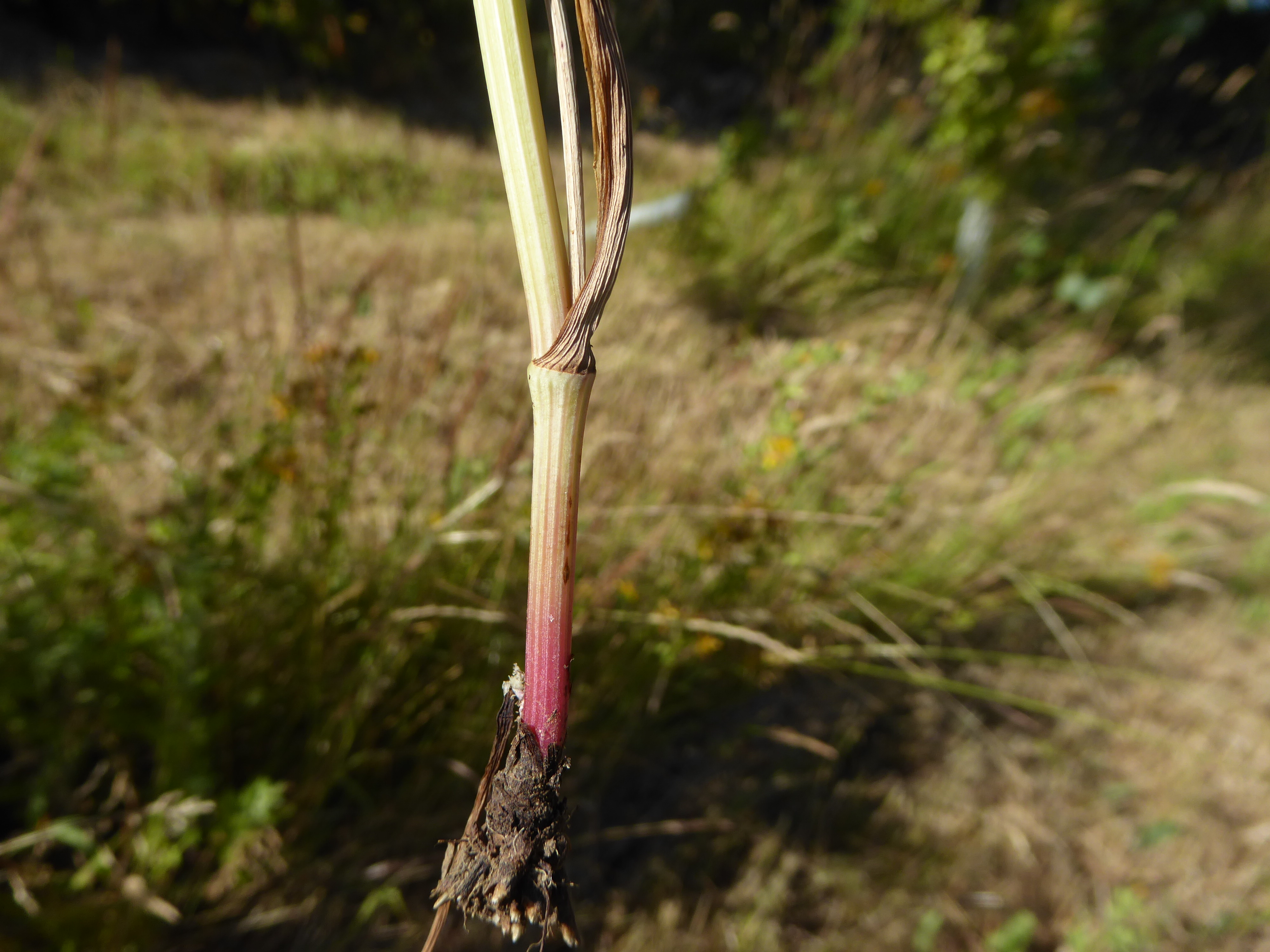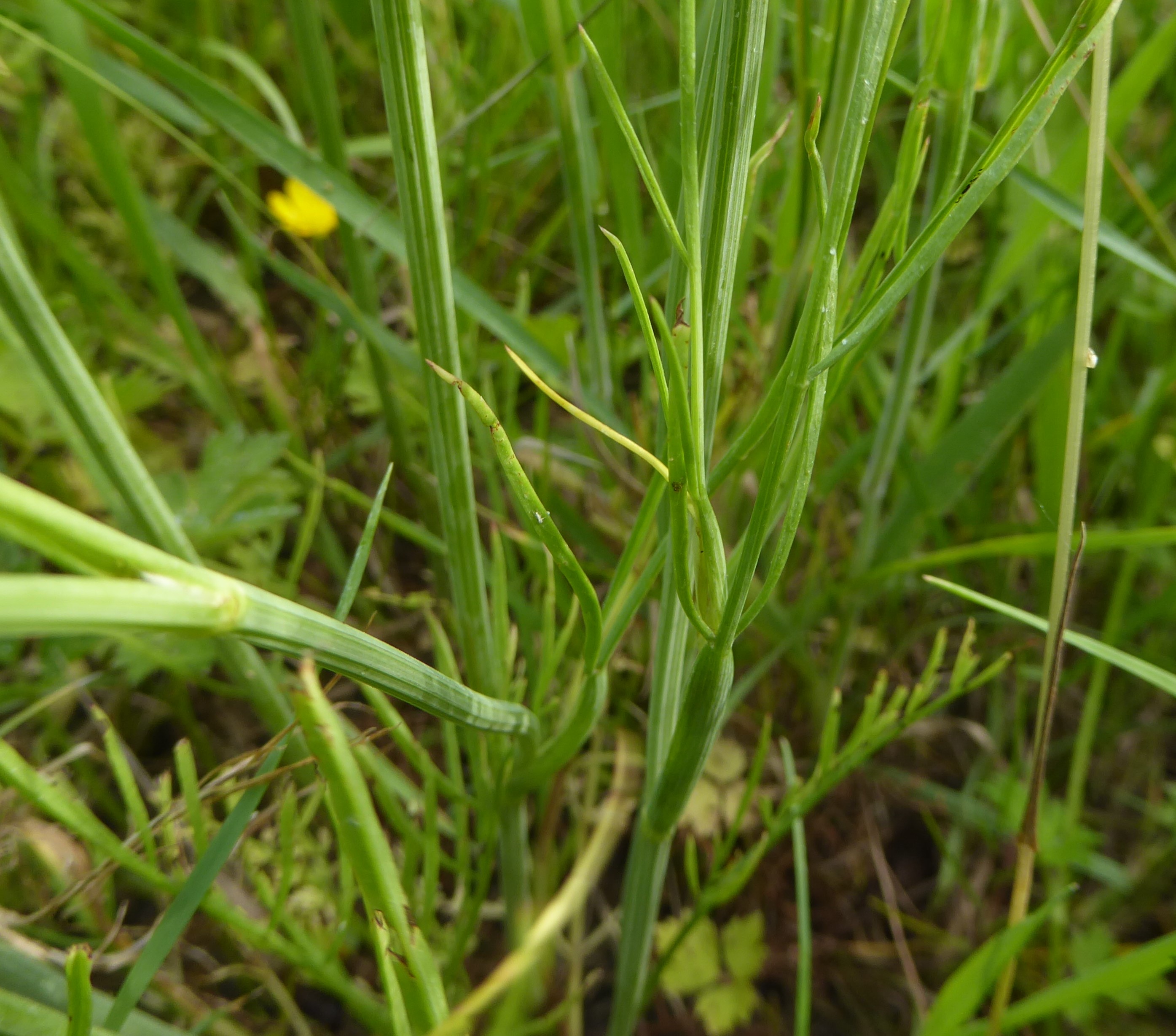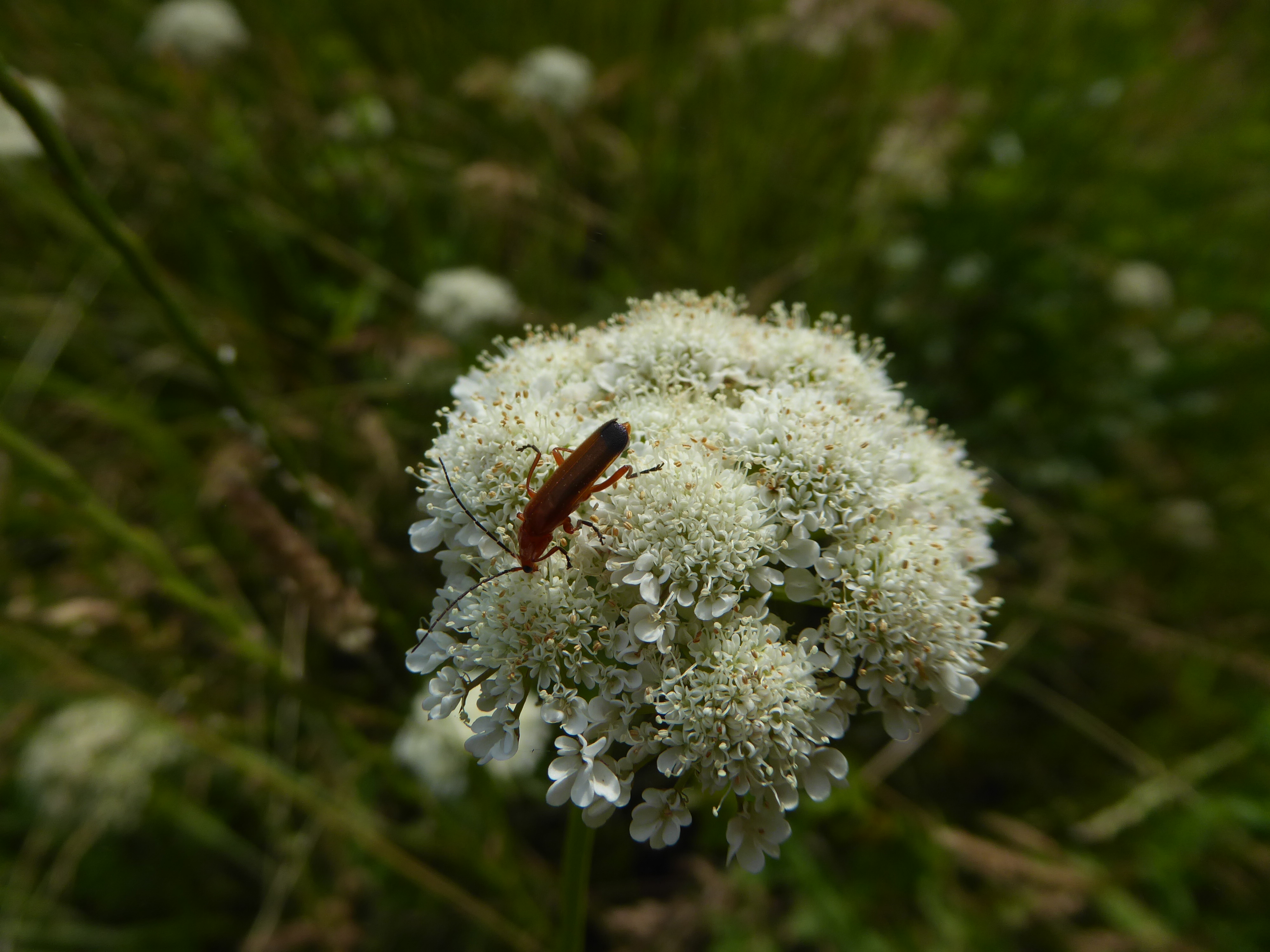Corky-fruited Water-dropwort on:
[Wikipedia]
[Google]
[Amazon]
''Oenanthe pimpinelloides'' is a species of flowering plant in the family Apiaceae known by the common name corky-fruited water-dropwort. It is a plant of damp or dry grassland and more ruderal tall herb communities.




 This is a plant of damp to dry grassland, hay meadows, old pastures and roadsides. Being more resistant to
This is a plant of damp to dry grassland, hay meadows, old pastures and roadsides. Being more resistant to 
 Corky-fruited water-dropwort is widely distributed in Europe, ranging from western Ireland and southern Britain to Turkey, then into western Asia including Israel, Jordon, Lebanon, and Syria. It also extends south through France, Spain, Portugal, and Morocco.
In the UK, its natural range is restricted to a few counties such as
Corky-fruited water-dropwort is widely distributed in Europe, ranging from western Ireland and southern Britain to Turkey, then into western Asia including Israel, Jordon, Lebanon, and Syria. It also extends south through France, Spain, Portugal, and Morocco.
In the UK, its natural range is restricted to a few counties such as

Description
Corky-fruited water-dropwort is a hairless, uprightperennial
A perennial plant or simply perennial is a plant that lives more than two years. The term ('' per-'' + '' -ennial'', "through the years") is often used to differentiate a plant from shorter-lived annuals and biennials. The term is also wide ...
with a solid, strongly grooved stem measuring up to 100 cm in height and 0.5 cm in diameter. The roots contain ovoid tubers a short distance from the base of the stem. The lanceolate to ovate lower leaves are twice pinnate with broad, toothed, cuneate segments 55 mm long and have a petiole up to 10 cm long. The petiole may exude sparse white latex when pierced. The upper leaves are once- or twice-pinnate, and the blade is at least the same length as the petiole; the linear, entire lobes are 10–30 mm long.Tutin TG. 1980. ''Umbellifers of the British Isles''. BSBI Handbook No. 2.
The main umbels
In botany, an umbel is an inflorescence that consists of a number of short flower stalks (called pedicels) that spread from a common point, somewhat like umbrella ribs. The word was coined in botanical usage in the 1590s, from Latin ''umbella'' "p ...
each have of 6–15 smooth rays, 1-2 cm long, which thicken after flowering. Below these rays is a whorl of up to 5 small linear-lanceolate bracts. The peduncles of the secondary umbels (umbellules) are longer than the rays and also thicken after flowering, producing fruiting heads that are distinctively flat-topped. Each umblellule is subtended by 12-20 small, linear bracteoles.
It flowers from June to August in the UK.Streeter D, Hart-Davies C, Hardcastle A, Cole F, Harper L. 2009. ''Collins Flower Guide''. Harper Collins The terminal umbels have both male-only and bisexual flowers, while the lateral umbels produce only male flowers. The non-fruiting male-only flowers are on longer stalks (pedicels) than the bisexual ones. Each tiny flower has 5 pointed, green sepals and 5 white petals, the outermost of which are slightly larger (a phenomenon known as "radiating"). There are 5 stamens, and 2 styles which project from the bulbous centre of the flower (the stylopodium). The stylopodium is the organ which secretes nectar onto its surface, attracting unspecialised species of pollinating insect, such as flies. The fruit is a schizocarp: a hard capsule that splits into two one-seeded mericarps as it matures. Each schizocarp is 3-3.5 mm long, with a prominent ridge on each mericarp. Like the rays and the peduncles, the individual pedicels also thicken after flowering.


Identification
Unlike other species in the genus, ''Oenanthe pimpinelloides'' has ovoid to globose root tubers (‘potatoes’) that are situated some distance from the base of the stem. Narrow-leaved water-dropwort may also have tubers of this shape (the only other species displaying such a character), but in contrast to ''O. pimpinelloides'', these are held close to the base of the plant. However, on the grounds of conservation and wildlife law, the plant should not be uprooted to examine this character for identification purposes; different morphological features and habitat context should be looked at instead. Amongst the British species, corky-fruited water-dropwort is distinctive because it tends to grow in dry habitats and has flat-topped umbels. The bracts distinguish it from narrow-leaved water-dropwort, which has similarly fine foliage. ''O. pimpinelloides'' has been frequently confused with the very similar ''O. incrassans'' in southeast Europe, which is sometimes treated as a subspecies.
Taxonomy and nomenclature
The scientific name for corky-fruited water-dropwort was coined by Peter Artedi, who developed the modernbinomial
Binomial may refer to:
In mathematics
*Binomial (polynomial), a polynomial with two terms
* Binomial coefficient, numbers appearing in the expansions of powers of binomials
*Binomial QMF, a perfect-reconstruction orthogonal wavelet decomposition
...
classification system, and defined the species on the basis of its involucral characters. It was published after Artedi's death by Linnaeus in Species Plantarum
' (Latin for "The Species of Plants") is a book by Carl Linnaeus, originally published in 1753, which lists every species of plant known at the time, classified into genera. It is the first work to consistently apply binomial names and was the ...
, in 1753, and that name still stands, although numerous synonyms have been proposed over the years, including ''Oenanthe globosa'' Georgi (1800), ''Oenanthe graminifolia'' Gaudin (1828), ''Oenanthe anatolica'' K. Koch (1846), and ''Phellandrium mathioli'' Bubani (1899). A full list can be found in the Synonymic Checklists of the Plants of the World.
The following subspecies are currently recognised: ''O. pimpinelloides'' subsp. ''incrassans'' (Bory & Chaub.) Strid (2012), which occurs only in Greece
Greece,, or , romanized: ', officially the Hellenic Republic, is a country in Southeast Europe. It is situated on the southern tip of the Balkans, and is located at the crossroads of Europe, Asia, and Africa. Greece shares land borders with ...
; ''O. pimpinelloides'' subsp. ''callosa'' (Salzm. ex DC.) Maire, which is found in Morocco
Morocco (),, ) officially the Kingdom of Morocco, is the westernmost country in the Maghreb region of North Africa. It overlooks the Mediterranean Sea to the north and the Atlantic Ocean to the west, and has land borders with Algeria to ...
and Spain
, image_flag = Bandera de España.svg
, image_coat = Escudo de España (mazonado).svg
, national_motto = ''Plus ultra'' (Latin)(English: "Further Beyond")
, national_anthem = (English: "Royal March")
, i ...
; and ''O. pimpinelloides'' subsp. ''pimpinelloides'', which accounts for all other populations but is rarely recorded.
There are no reported hybrids.
Its chromosome number is 2n = 22.
The scientific name "''Oenanthe''" comes from the Greek οίνος, "wine" and άνθος, "flower", not because the flowers have the scent of wine, but because of the intoxication caused by a related species, hemlock water-dropwort
''Oenanthe crocata'', hemlock water-dropwort (sometimes known as dead man's fingers) is a flowering plant in the Apiaceae, carrot family, native to Europe, North Africa and western Asia. It grows in damp grassland and wet woodland, often along ri ...
. The Latin specific epithet
In taxonomy, binomial nomenclature ("two-term naming system"), also called nomenclature ("two-name naming system") or binary nomenclature, is a formal system of naming species of living things by giving each a name composed of two parts, bot ...
“pimpinelloides” means “resembling ''Pimpinella
''Pimpinella'' is a plant genus in the family Apiaceae; it includes the aromatic herb anise ''(Pimpinella anisum, P. anisum)''.genus
Genus ( plural genera ) is a taxonomic rank used in the biological classification of extant taxon, living and fossil organisms as well as Virus classification#ICTV classification, viruses. In the hierarchy of biological classification, genus com ...
.
Habitat and ecology
 This is a plant of damp to dry grassland, hay meadows, old pastures and roadsides. Being more resistant to
This is a plant of damp to dry grassland, hay meadows, old pastures and roadsides. Being more resistant to water stress
Water scarcity (closely related to water stress or water crisis) is the lack of fresh water resources to meet the standard water demand. There are two types of water scarcity: physical or economic water scarcity. Physical water scarcity is where ...
than its congeners, it is the only water-dropwort that grows in dry lowland habitats in some parts of its natural range. Although it is usually described as a grassland plant, its habitat is often somewhat ruderal and tending towards scrub. This is perhaps why it is not listed in any of the vegetation communities of the National Vegetation Classification in Britain. In Sardinia, it has been described as a plant of myrtle scrub around Mediterranean temporary ponds, and in Turkey it is often found under hazel trees.
Its Ellenberg values in Britain are L = 7, F = 7, R = 6, N = 3, and S = 0.
Five species of insect are known to feed on corky-fruited water-dropwort in the UK. Three of these are flies: ''Kiefferia pericarpiicola
''Kiefferia pericarpiicola '' is a species of fly in the family Cecidomyiidae. It is found in the Palearctic.Bei-Bienko, G.Y. & Steyskal, G.C. (1988) ''Keys to the Insects of the European Part of the USSR'', Volume V: Diptera and Siphonaptera, P ...
'' larvae produce galls on the flowers and seeds; ''Lasioptera
''Lasioptera'' is a genus of gall midges in the family Cecidomyiidae
Cecidomyiidae is a family of flies known as gall midges or gall gnats. As the name implies, the larvae of most gall midges feed within plant tissue, creating abnormal plant ...
carophila'' is a midge which also produces galls in the flowers or stems; and carrot fly
The carrot fly (''Chamaepsila rosae'') is a pest of gardens and farms, and mainly affects the crop of carrots, but can also attack parsnips, parsley and celery. It is a member of the family Psilidae (order Diptera).
Larvae
Crop damage is caused ...
can attack the roots. The remaining two species are Lepidoptera
Lepidoptera ( ) is an order (biology), order of insects that includes butterfly, butterflies and moths (both are called lepidopterans). About 180,000 species of the Lepidoptera are described, in 126 Family (biology), families and 46 Taxonomic r ...
: ''Depressaria daucella
''Depressaria daucella'' is a moth of the family Depressariidae. It is found in most of Europe, except most of the Balkan Peninsula. It is also found in North America.
The wingspan is 21–24 mm. The terminal joint of palpi with two blacki ...
'' caterpillars feed among the flowerheads, while ''Agonopterix yeatiana
''Agonopterix yeatiana'' is a moth of the family Depressariidae. It is found in most of Europe.
The wingspan is 19–23 mm. The forewings are pale greyish ochreous, with a few black scales; veins sometimes marked with cloudy dark fuscous st ...
'' larvae roll the leaves and shoots.
''O. pimpinelloides'' can be a noxious weed
A noxious weed, harmful weed or injurious weed is a weed that has been designated by an agricultural or other governing authority as a plant that is injurious to agricultural or horticultural crops, natural habitats or ecosystems, or humans or liv ...
in New Zealand on account of its vigorous, persistent growth where no natural enemies occur, potentially outcompeting native eucalypts.

Distribution and status
 Corky-fruited water-dropwort is widely distributed in Europe, ranging from western Ireland and southern Britain to Turkey, then into western Asia including Israel, Jordon, Lebanon, and Syria. It also extends south through France, Spain, Portugal, and Morocco.
In the UK, its natural range is restricted to a few counties such as
Corky-fruited water-dropwort is widely distributed in Europe, ranging from western Ireland and southern Britain to Turkey, then into western Asia including Israel, Jordon, Lebanon, and Syria. It also extends south through France, Spain, Portugal, and Morocco.
In the UK, its natural range is restricted to a few counties such as Somerset
( en, All The People of Somerset)
, locator_map =
, coordinates =
, region = South West England
, established_date = Ancient
, established_by =
, preceded_by =
, origin =
, lord_lieutenant_office =Lord Lieutenant of Somerset
, lord_ ...
, Dorset
Dorset ( ; archaically: Dorsetshire , ) is a county in South West England on the English Channel coast. The ceremonial county comprises the unitary authority areas of Bournemouth, Christchurch and Poole and Dorset (unitary authority), Dors ...
, and Hampshire
Hampshire (, ; abbreviated to Hants) is a ceremonial county, ceremonial and non-metropolitan county, non-metropolitan counties of England, county in western South East England on the coast of the English Channel. Home to two major English citi ...
; where it is locally common. However, it may be naturalized elsewhere in the country, such as in Cambridgeshire
Cambridgeshire (abbreviated Cambs.) is a Counties of England, county in the East of England, bordering Lincolnshire to the north, Norfolk to the north-east, Suffolk to the east, Essex and Hertfordshire to the south, and Bedfordshire and North ...
. In 2006, several plants were discovered growing around fishermen’s platforms dug into the bank of a lake at RAF Waterbeach. The following year, about a dozen plants were found growing in a naturalized state on a lawn around a small pond at the British Antarctic Headquarters at High Cross, Cambridge.
A new Irish record for the species was made at Duncannon
Duncannon () is a village in southwest County Wexford, Ireland. Bordered to the west by Waterford harbour and sitting on a rocky headland jutting into the channel is the strategically prominent Duncannon Fort which dominates the village.
Pri ...
in County Wexford
County Wexford ( ga, Contae Loch Garman) is a county in Ireland. It is in the province of Leinster and is part of the Southern Region. Named after the town of Wexford, it was based on the historic Gaelic territory of Hy Kinsella (''Uí Ceinns ...
in 2006.
Uses
The related specieshemlock water-dropwort
''Oenanthe crocata'', hemlock water-dropwort (sometimes known as dead man's fingers) is a flowering plant in the Apiaceae, carrot family, native to Europe, North Africa and western Asia. It grows in damp grassland and wet woodland, often along ri ...
is highly poisonous, and it is often assumed that corky-fruited water-dropwort would be similarly dangerous, but there is no record of it ever harming humans or livestock, and often occurs in hay meadows and pastures without any ill effect on cattle, sheep or horses.
In Turkey it is reported to be consumed by the locals after roasting or cooking with yoghurt and bulgur wheatOzbek K, Karabak S, Aysar N, Guzelsoy NA, Nurgal SARI, Duran RM, Tasci R, Guner B, Yucearslan H, Deniz D, Aksoy A. 2017. Biodiversity for food and nutrition project: Black Sea region studies ''ANADOLU Ege Tarımsal Araştırma Enstitüsü Dergisi'' 27(2): 17 - 25. or pickled and cooked in the winter. It is said to be used as a digestive stimulant.
References
{{Taxonbar, from=Q939506 Apioideae Plants described in 1753 Taxa named by Carl Linnaeus